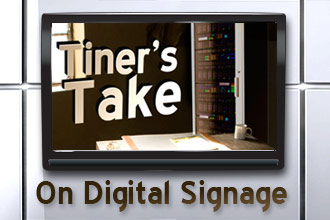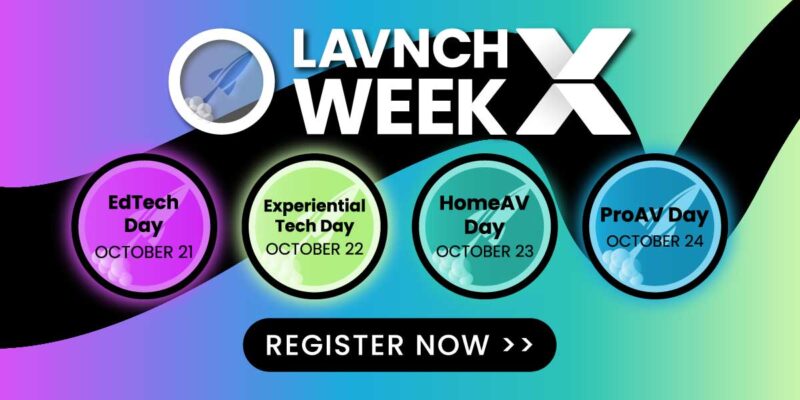Point Of Wait in the Educational Setting
 In the July edition of rAVe DS, there was a fantastic article by Keith Kelsen. If you did not get the chance to read this article last month, it is worth a read now. If you did read it last month, it is worth a reread. Go ahead, do it now, I will wait.
In the July edition of rAVe DS, there was a fantastic article by Keith Kelsen. If you did not get the chance to read this article last month, it is worth a read now. If you did read it last month, it is worth a reread. Go ahead, do it now, I will wait.
OK, you are back. Despite being a great article, Keith left out the education market as a whole, which makes sense, because it is such a difficult market to understand. Some of the categories he listed inside of each type of network certainly can apply to education, but there was no drill down into specific uses and examples. Well, that is why I am here.
As I wrote about in my last article DS in education is difficult because we don’t (in many cases) have that clear point of sale, or purchase. Kelson would refer to this type of network as the Point of Sale network. Of course, we do have bookstores, cafes and other retail locations on campus, but they are not the majority of what we do. I think that Kelson would put most of what you find in colleges and universities into the Point of Transit and Point of Wait categories.
Let’s talk about the Point of Wait digital signage. This is an application that could have an upfront cost that scares our customers. Most digital signage applications I have dealt with cost anywhere from $5,000 to $10,000 per unit. That seems like a lot of money to “entertain” someone while they wait for something. However, let’s take Kelson’s examples and find out how we could put some value into these signs.
Several Point of Wait areas in colleges and universities where we can make valuable use out of that customer who is “dwelling” in our spaces come to mind: an admissions office as families wait for a tour or interview, a waiting room outside of the advancement offices, lines in the finance offices during the start of the term, and perhaps the waiting rooms outside of an athletic coaches office. Indeed, even in the education sector there are many points of wait.
Each of these situations provide an opportunity for us to create an environment for our customers. In the admissions office, we have students who are excited about visiting a school, parents who are nervous about letting their children go and both are nervous about whether they will get accepted and how much it will cost. We can directly address each of these issues with creative and thoughtful bulletins on our signage system. Photos and textual data about costs and programs is important, but how about videos of students from different disciplines talking about their experiences, or current students talking about their experiences during their first year? Perhaps these can even be students who the prospective families can meet later in the day or correspond with via social media. Add a Twitter tag to the students who are in the video, so that they can be easily followed.
The waiting room outside of an advancement office is a tricky one. You probably don’t want a high value donor sitting around waiting for you to find time for them. However, it is also a great opportunity to set the mood. A great video essay, with textual information about current projects going on at your institution could prime the pump for the potential donor. They can come into a situation asking you questions, instead of you needing to lead the horse to water. Better yet, what if you have a really big donor who has already given you some money. Perhaps a well timed photo essay documenting where his/her money has gone, and any buildings or rooms named after him/her. If the person is an alumnus, how about some pictures from when he was in school, or “class notes” on his fellow classmates? The technology exists with current digital signage to allow these changes to be timed to the minute, to get your maximum exposure and bang for the buck.
Every parent fears the day she needs to write out a check for tuition to her son or daughter’s college. Every student fears waiting in line to ask questions about student loans, entrance interviews, exit interviews and how much various fees are. This is a time where the tensions run high, frustration is high and questions are mounting. A well placed digital sign that serves two purposes, answering questions, and presenting a calming environment could be very helpful here. Kelson would point out that in this situation people are a “captive audience” so the content can be more lengthy and detailed than in a point of transit. Information that details various payment options, loan arrangements and details of past students can help reassure families they are making the correct choice. It also serves your employees well, as by the time customers get to their counter, they are calmer and less frustrated.
Sports is big money in colleges and universities around our country. A lot of money is invested in recruiting talented scholar athletes. There are many rules that the NCAA places around recruiting and what you can and cannot do. For example, you are not allowed to put up signs welcoming specific recruits. However, you are allowed to do other things. Putting up your historical stats and last year’s record would be interesting to prospective athletes. Also, for the athlete and their parents, perhaps information about the success of scholar athletes at your institution would be valuable and interesting. Video highlights could be shown to excite your visitors. Again, with the current technology this can all be timed to meet the need of your specific audience at any specific time. Just remember to consult with your NCAA compliance officer before doing any of this.
Another consideration is about where technology currently exists that you could add digital signage. Do you have a conference room for your president, for your trustees? If technology exists in this space, then adding digital signage could be made much cheaper by taking advantage of what exists. Add a digital signage box into the system and program the system to run it while there is no other presentation going on. Now, you are dipping your toe into the waters, but without a large investment. This would also be a great way for an integrator to sell signage to a customer and maybe spark some interest in a larger system.
While each of these uses of DS could loosely be considered some type of Points of Sale, they are mostly a Points of Wait, due to the fact that they are viewed by captive audience to whom you are able to provide them with a more time intensive, detailed and personalized experience. Whether you are a public relations firm advising a communications office, an integrator trying to pitch a product or a technology manager asked to spec equipment, you need to understand these potential uses in a Point of Wait education setting.
As always, I would love to hear from you. Are you using any of these scenarios in your institution? Are you an integrator who has some questions on how to best pitch these products to an educational customer? If so, give me a shout! I look forward to hearing from you.





